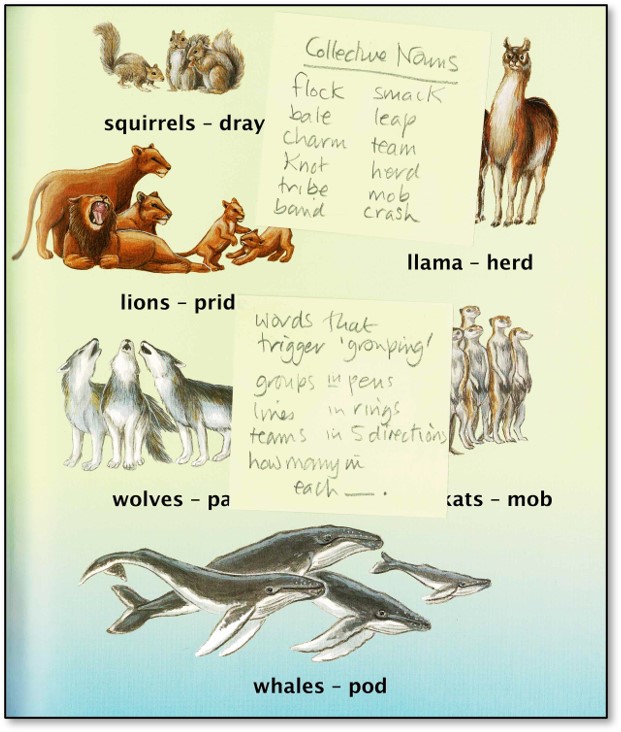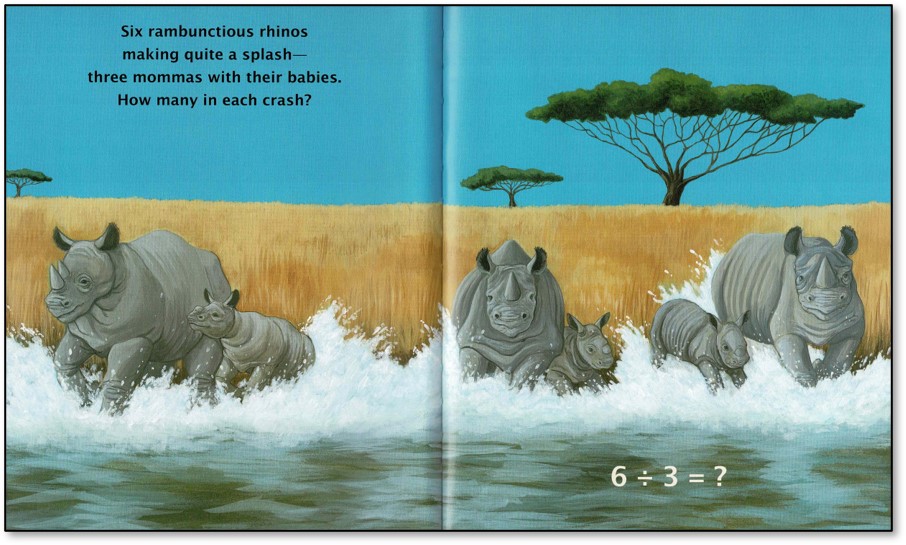Multiplication and Division
Collective Nouns, Factors and Division
Over the last 12 months we have had a major focus on multiplicative thinking. As usual we have trawled through our collection of multiplicative picture books and over the next few blogs, we’ll share a few of them with you. Today we are going to take a close look at The Great Divide and we think that you will agree with us that it is a very clever and useful book to use for multiplicative thinking and division in particular.
It can be used to help to:
- introduce division as sharing into equal sized groups in interesting contexts
- enrich the language and conceptual understanding of division and multiplication through naming ways of grouping, (teams, in rings, in lines) as well as using collective nouns, (herd, crash, mob)
- focus on how many are in each of the groups just formed
- make connections between division and multiplication as inverse operations
- introduce factors
I used my post-it approach to list the multiplication and division language in the book, which is very rich, as demonstrated on the image below.

Misconceptions and Gaps About Division
It is the beginning of the school year and some teachers have been using tests such as the SENA test to collect data and find out where their students are at. While this might not be my go-to, there is no doubt that some of the questions are quite revealing. The SENA test for multiplicative thinking includes a question as briefly described below with three related parts.
- What is 8 × 4?
- What is 32 ÷ 4?
- What is 9 × 4?
Teachers using this test reported that most students either had instant recall or could quickly work out 8 × 4 (double 8 and double again). However, few students could use their multiplication fact knowledge to work out the next question: 32 ÷ 4 which is simply the inverse operation. Some students said that they hadn’t learnt division yet and some said, “I hate division”.
When it came to the question 9 × 4 very few students could build on the earlier fact 8 × 4 to work out 9 × 4 although many had an idea about adding on but only added 1 to give the answer 33. They knew they had to add one more but not one more what.
With the above information fresh in my mind, I chose The Great Divide as the first picture book in this series of blogs.
Equal Sized Groups and Collective Nouns
The Great Divide is all about creatures forming into equal sized groups which is something we need to check all students are confident with. Believe it or not, not all students have had sufficient concrete and visual experiences required to develop an understanding of equal-sized groups as countable units. Skip counting on its own is only meaningless rote and recall. For students who have not made connections between skip counting and countable units, this book could open up some ways to explore and talk about skip counting the groups instead of counting all by ones.
Each page shows a division sentence, e.g.

Just ensure your students can read the division sentences correctly; it is 15 divided by 3 not 3 divided by 15. It no longer surprises me how many students and adults do not read division sentences correctly.
The rhyming text quite clearly states how many creatures there were to start with, and the images shows how many groups and how many in each group, exactly matching the given division sentence.
Different ways of flagging the action of division are stated in the book where we see and hear many examples (group, team, line, in three rings). The use of collective nouns is very clever focusing attention on how many are in each group by naming the groups (herd, mob, pod, crash).
Connecting Multiplication and Division
Ever since I came into teaching (a hundred years go or so it sometimes seems) there have been two distinct differences of opinion amongst teachers as to whether multiplication should be taught separately before introducing division or whether the two should be introduced together as they are so closely related.
I always find it strange that students come to school already sharing ‘fairly’ into equal sized groups or parts, ‘2 for you, 2 for me’, and yet we go straight into multiplication not building on what students do already know about.
Immaterial to that is the fact that many students do not connect multiplication facts with division facts. Using each double page spread in the book we can ask questions to help make those connections.

Division questions could include:
“How many rambunctious rhinos were making quite a splash?”
“How many crashes did they get into?”
“How many rhinos in each crash?
“What is the matching division sentence?”
Questions to link the inverse multiplication fact could include:
“When the rhinos come back together on land how many will there be?”
(The answer 6 because there are 3 crashes with 2 rhinos in each crash and 3 × 2 = 6).
Follow Up
Some students might enjoy choosing their own creature and matching collective noun and then creating their own double page spread for a class version of the book.
Factors and Fractions
The teaching notes at the end of the book offer some ideas for connecting division factors and fractions.
Now, while you are here, go and check out our multiplicative thinking resources:
- Building Multiplicative Strategies
- Multiplication Strategy Mat
- and our recently revised Multiplication Grid.
As always, have fun with it and let us know how you go. Yours in maths.

